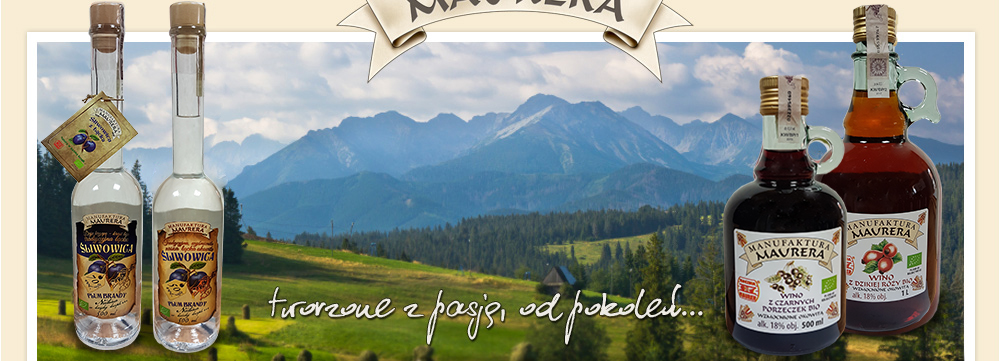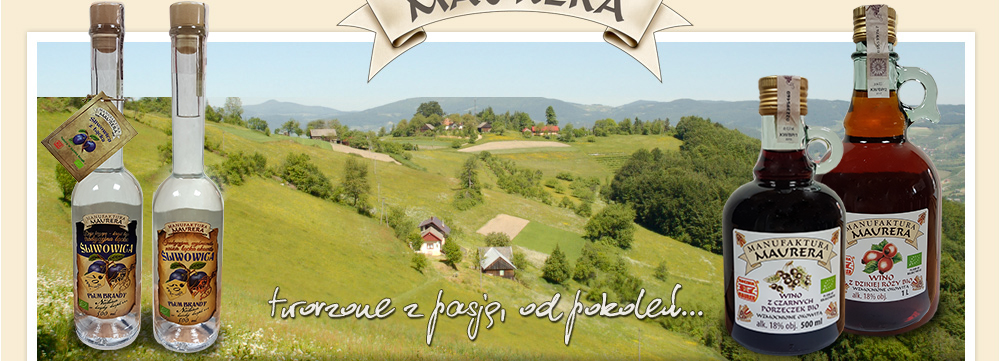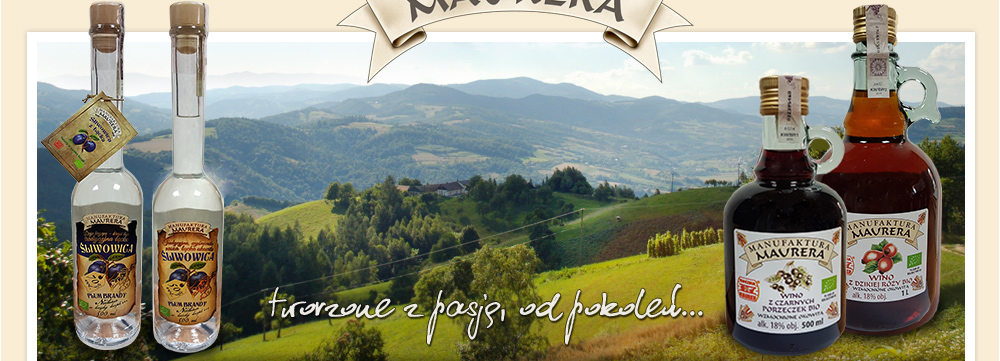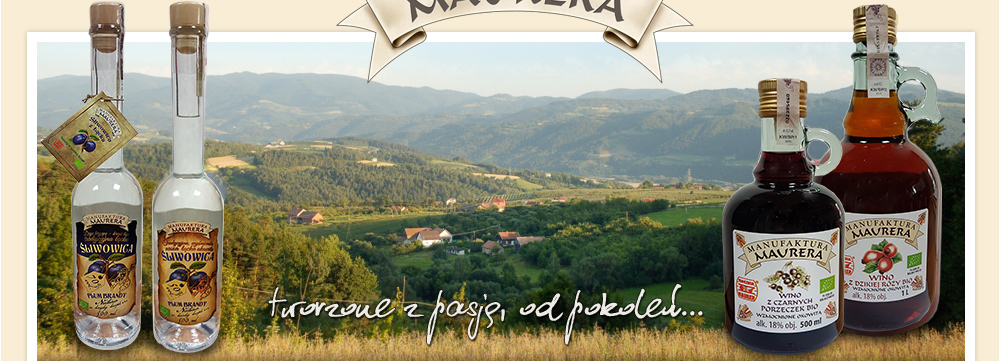History
"Aquavit was drunk by our ancestors Polans
Moonshine is made by Germans, hooch by Russians
Somewhere in the mountain province
Łącko is famous for its slivovitz."
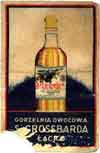 As it appears from historical sources, the cultivation of plums was known in the region of Łącko in the 12th century. Dried fruits were floated down the Danube to the Vistula and, then, to Gdańsk from which they were transported by water to other European countries. It was also popular to make plum jam, which was supported by the wife of Bolesław V the Chaste, princess Kinga of Poland. However, there are no historical sources from that period confirming if her subjects knew the technology of 'liquefying' plums. In the 17th and 18th centuries, there were great plum and apple orchards in this region. Manor protocols from the inspection carried out in 1698 say among other things that the part of cottagers had an obligation to pick up fruits and deliver them to the court as serfdom. It is assumed that some part of fruits was intended for the production of this vintage alcoholic beverage. In 1830, the secretary of the communal property, Herzog, who was a great enthusiast of fruit farming, founded a nursery of fruit trees and sold new varieties of plum trees, apple trees and pear trees even outside Poland.
As it appears from historical sources, the cultivation of plums was known in the region of Łącko in the 12th century. Dried fruits were floated down the Danube to the Vistula and, then, to Gdańsk from which they were transported by water to other European countries. It was also popular to make plum jam, which was supported by the wife of Bolesław V the Chaste, princess Kinga of Poland. However, there are no historical sources from that period confirming if her subjects knew the technology of 'liquefying' plums. In the 17th and 18th centuries, there were great plum and apple orchards in this region. Manor protocols from the inspection carried out in 1698 say among other things that the part of cottagers had an obligation to pick up fruits and deliver them to the court as serfdom. It is assumed that some part of fruits was intended for the production of this vintage alcoholic beverage. In 1830, the secretary of the communal property, Herzog, who was a great enthusiast of fruit farming, founded a nursery of fruit trees and sold new varieties of plum trees, apple trees and pear trees even outside Poland.
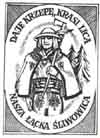 Family traditions of current residents of Łącko date back to the turn of the 19th and 20th centuries. At that time, the parish lands were leased by a Jewish family of the Grossbard. Then, the parish priest of Łącko, priest Korab Pociełowski, did not object to the family opening a distillery on the manor farm 'of the duke'. So in the years 1882-1912, on the territory of the commune, there was a distillery of slivovitz – Samuel Grossbard was the owner while Salomon Goldchein was the distiller. The distillery produced Śliwowica Pejseczna (Pejseczna Slivovitz), which was distributed to shops and licensed premises in Łącko as well as other towns. Bottles with Śliwowica Pejseczna had the first in the history of this alcoholic beverage label. The distillery constituted the main source of income of the commune under the so-called propination laws.
Family traditions of current residents of Łącko date back to the turn of the 19th and 20th centuries. At that time, the parish lands were leased by a Jewish family of the Grossbard. Then, the parish priest of Łącko, priest Korab Pociełowski, did not object to the family opening a distillery on the manor farm 'of the duke'. So in the years 1882-1912, on the territory of the commune, there was a distillery of slivovitz – Samuel Grossbard was the owner while Salomon Goldchein was the distiller. The distillery produced Śliwowica Pejseczna (Pejseczna Slivovitz), which was distributed to shops and licensed premises in Łącko as well as other towns. Bottles with Śliwowica Pejseczna had the first in the history of this alcoholic beverage label. The distillery constituted the main source of income of the commune under the so-called propination laws.
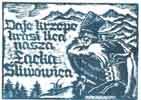 On the territory of Łącko, privileges arising out of the propination laws were granted to the Jewish who had all rights connected with importing and selling alcoholic beverages. Other residents were allowed to import alcohol only in exceptional circumstances, such as weddings, provided that they had informed the Jewish. Otherwise, the goods were confiscated and a fine was imposed on a buyer. Peasants often evaded the propination laws by producing vodka at their own expense, so-called moonshine. It was produced illicitly from fruits and rye. After the death of priest Korab Pociełowski (1912), priest Piaskowy moved to Łącko who had a different approach to the production of alcoholic beverages in this region. He disapproved the production of alcoholic beverages of any kind, especially slivovitz.
On the territory of Łącko, privileges arising out of the propination laws were granted to the Jewish who had all rights connected with importing and selling alcoholic beverages. Other residents were allowed to import alcohol only in exceptional circumstances, such as weddings, provided that they had informed the Jewish. Otherwise, the goods were confiscated and a fine was imposed on a buyer. Peasants often evaded the propination laws by producing vodka at their own expense, so-called moonshine. It was produced illicitly from fruits and rye. After the death of priest Korab Pociełowski (1912), priest Piaskowy moved to Łącko who had a different approach to the production of alcoholic beverages in this region. He disapproved the production of alcoholic beverages of any kind, especially slivovitz.
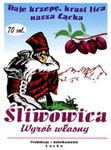 Further history of Śliwowica Łącka (Slivovitz of Łącko) before the World War II is connected with Pinkas Ferber who got married to the daughter of Samuel Grossbard. He ran the production of Koszerna Śliwowica (Kosher Slivovitz) on an industrial scale. But before it happened, he had to wait until the attitude of priest Jan Piaskowy would be forgotten. Legal situation was in his favour; the parish lands were largely taken over by the group who leased it to Ferber. Ferber started buying plums and processing them in the distillery. Probably, he developed the stripping technique also known and used by current residents of the town. To the production of slivovitz he used only the highest quality fruits, the fermentation took place spontaneously and to the stripping process he used copper vessels. The stripping process was carried out very slowly with the use of central fraction only. Alcohol prepared in such a way matured for a long time in oak barrels and, then, it was bottled. Most of the production was exported, mainly to Palestine. Ferber's distillery produced approximately 2000dm3 of slivovitz annually, but the production was suspended due to the outbreak of the World War II. After the war, slivovitz is often called Krasilica. This term was created from a famous highland saying: Daje krzepę krasi lica nasza Łącka śliwowica (Strength is what you get from our slivovitz from Łącko). As the Highlanders from Łącko say: Krasilica is a vodka with which you can't get drunk, you have to taste it as a superfine brandy, but when tasting, you have to take care, because it is very treacherous. It gently passes through the throat, you don't feel its strength at all, it leaves a wonderful flavour and aroma in your mouth, but if you take one sip too much, it knocks you off your feet as a sheaf of oat.
Further history of Śliwowica Łącka (Slivovitz of Łącko) before the World War II is connected with Pinkas Ferber who got married to the daughter of Samuel Grossbard. He ran the production of Koszerna Śliwowica (Kosher Slivovitz) on an industrial scale. But before it happened, he had to wait until the attitude of priest Jan Piaskowy would be forgotten. Legal situation was in his favour; the parish lands were largely taken over by the group who leased it to Ferber. Ferber started buying plums and processing them in the distillery. Probably, he developed the stripping technique also known and used by current residents of the town. To the production of slivovitz he used only the highest quality fruits, the fermentation took place spontaneously and to the stripping process he used copper vessels. The stripping process was carried out very slowly with the use of central fraction only. Alcohol prepared in such a way matured for a long time in oak barrels and, then, it was bottled. Most of the production was exported, mainly to Palestine. Ferber's distillery produced approximately 2000dm3 of slivovitz annually, but the production was suspended due to the outbreak of the World War II. After the war, slivovitz is often called Krasilica. This term was created from a famous highland saying: Daje krzepę krasi lica nasza Łącka śliwowica (Strength is what you get from our slivovitz from Łącko). As the Highlanders from Łącko say: Krasilica is a vodka with which you can't get drunk, you have to taste it as a superfine brandy, but when tasting, you have to take care, because it is very treacherous. It gently passes through the throat, you don't feel its strength at all, it leaves a wonderful flavour and aroma in your mouth, but if you take one sip too much, it knocks you off your feet as a sheaf of oat.
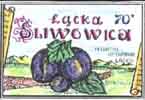 Śliwowica Łącka is a beverage of a strength of more than 70% vol., having a typical clearly plum flavour. It is a colourless liquid, because it does not mature as Feberówka (Ferber's slivovitz) did in oak barrels. It is produced illegally and it is kept outside recorded trade. For several years, the residents of Łącko have been trying to legalize the production of slivovitz, but there are still no regulations which would authorize its production.
Śliwowica Łącka is a beverage of a strength of more than 70% vol., having a typical clearly plum flavour. It is a colourless liquid, because it does not mature as Feberówka (Ferber's slivovitz) did in oak barrels. It is produced illegally and it is kept outside recorded trade. For several years, the residents of Łącko have been trying to legalize the production of slivovitz, but there are still no regulations which would authorize its production.
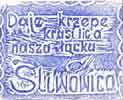 The tradition of designing own labels was born with the label of Śliwowica Pejseczna appearing in Łącko. Own label was a symbol of high quality and a proof that the producer has high qualifications. The production of labels was very simple, it consisted in impressing stamps on paper. Labels were often hand-made, which ensured their uniqueness. Currently illegally produced slivovitz has traditional labels or labels printed with the use of modern techniques.
The tradition of designing own labels was born with the label of Śliwowica Pejseczna appearing in Łącko. Own label was a symbol of high quality and a proof that the producer has high qualifications. The production of labels was very simple, it consisted in impressing stamps on paper. Labels were often hand-made, which ensured their uniqueness. Currently illegally produced slivovitz has traditional labels or labels printed with the use of modern techniques.
From the collection of Sądecki Kolberg

